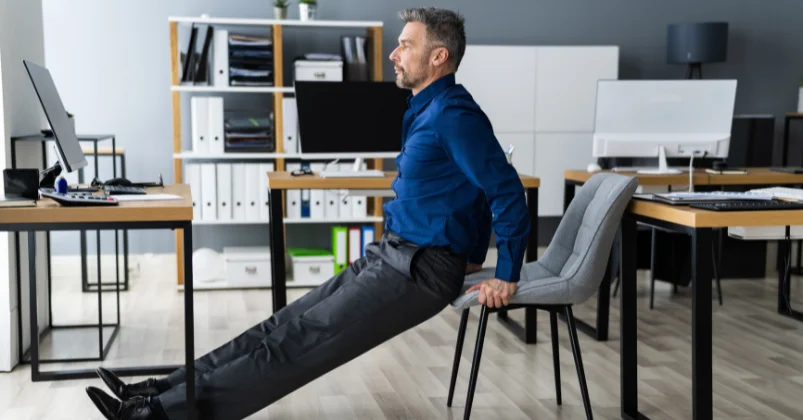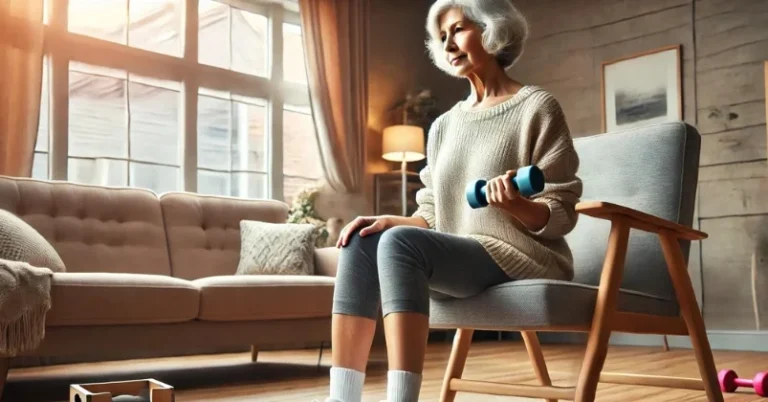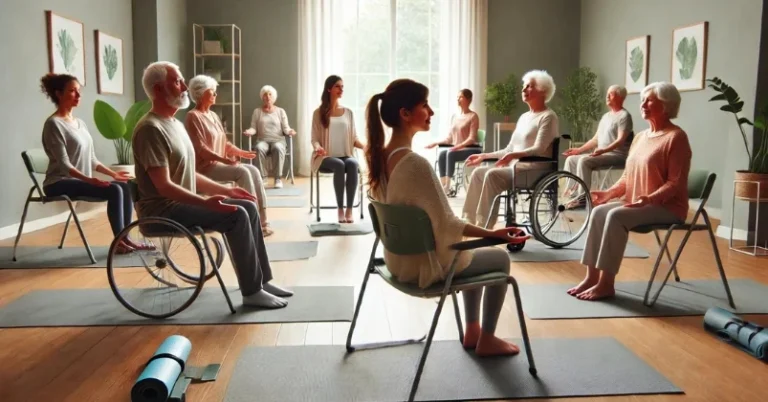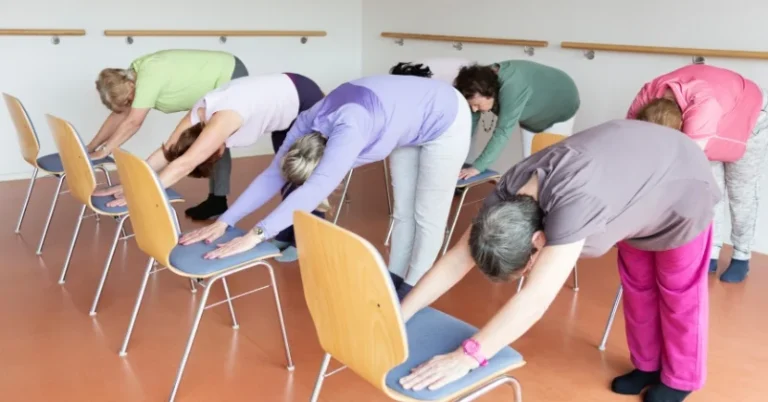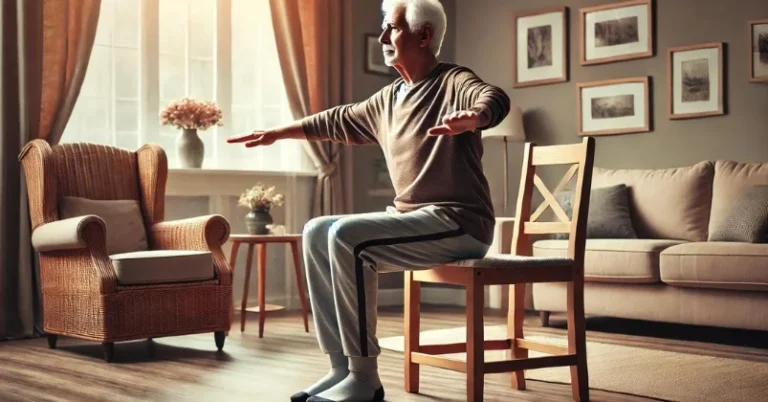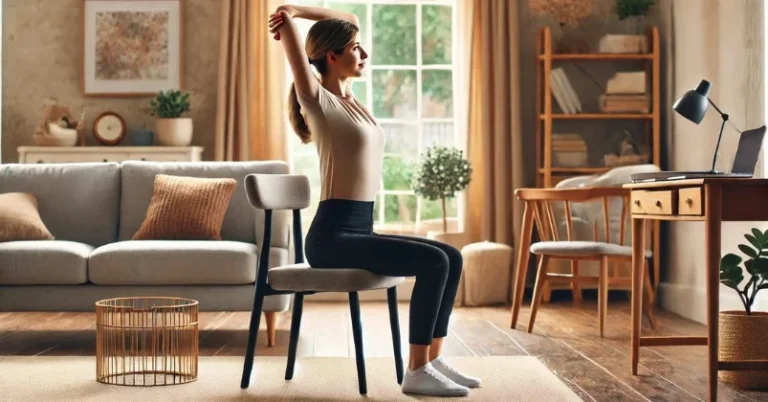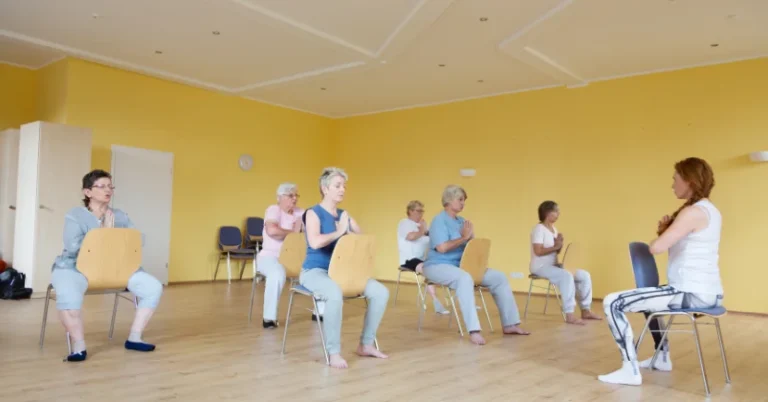Unlock the Benefits of Chair Exercises for Chronic Conditions: A Comprehensive Guide
The beloved chair—our trusty sidekick through coffee dates, book club gatherings, and those late-night phone calls with old friends. But who knew this homey piece of furniture could be your new partner in crime for health and wellness, too?
Whether you're a seasoned gym bunny looking for a gentler routine or you're working through a chronic condition like arthritis or osteoporosis, chair exercises could be your golden ticket to staying spry and fabulous.
Forget the intimidation of high-intensity workouts or the worry of worsening your condition. Chair exercises are all about comfort, ease, and effectiveness. We're talking better posture, less stiffness, more flexibility, and even a happier mood—right from the comfort of your chair. Talk about multitasking, ladies!
But the cherry on top? These chair-robics (see what we did there?) are perfect for custom tailoring to your specific needs and conditions. Got arthritis?
There's a chair exercise for that. Battling osteoporosis? Yep, we've got you covered there too. Parkinson's? No problem.
Imagine the possibilities of a tailored workout plan that’s gentle on the joints but tough on your condition's nagging symptoms.
So, if you're living the chronic condition life, or simply yearning for a softer yet effective exercise routine, let's unlock the amazing benefits that chair exercises can offer. Lean back—or better yet, sit up straight (your posture will thank you)—and let's get this wellness party started!
Understanding Chair Exercises
Ever wondered how you could get that cardio glow without stepping a foot out of your living room—or even out of your seat? Welcome to the world of chair exercises, a transformative approach to fitness that's about as cozy as your favorite throw blanket and as effective as that cleanser you swear by for flawless skin.
Chair exercises are like your morning coffee but for your heart and muscles—revitalizing, energizing, and just the right amount of kick to get you going.
But instead of giving you jitters, they give you a pumped-up heart rate, strong muscles, and fabulous flexibility.
Oh, and let's not forget how they're superstars at staving off life’s pesky curveballs like heart disease, diabetes, and even that waistline creep we often blame on metabolism or stress.
The best part? Chair exercises are the jeans of the workout world—they fit you, no matter your size, age, or level of fitness.
Whether you're a newbie who thinks a burpee is a noise a baby makes, or a fitness aficionado used to sweating it out, these exercises can be tailored just for you.
Think of them as your made for you fitness plan, designed to suit your unique body and health profile.
Feeling a little adventurous? Ramp up the intensity and the number of reps. Need something more gentle? No worries, you can dial it down while still getting those gains.
And let's not leave out our wisest, most experienced crowd. If you're in the golden years of life, chair exercises are practically a love letter to your well-being.
Say goodbye to the days when standing for too long felt like an Olympic sport. With chair exercises, you can keep fit, fabulous, and focused—no standing ovation required.
Chair exercises are not just about physical fitness; they’re your daily dose of mental sunshine, too. Now, who's ready to take their trusty chair from reading nook staple to wellness wonder?
Some of the Benefits of Chair Exercises for Chronic Conditions
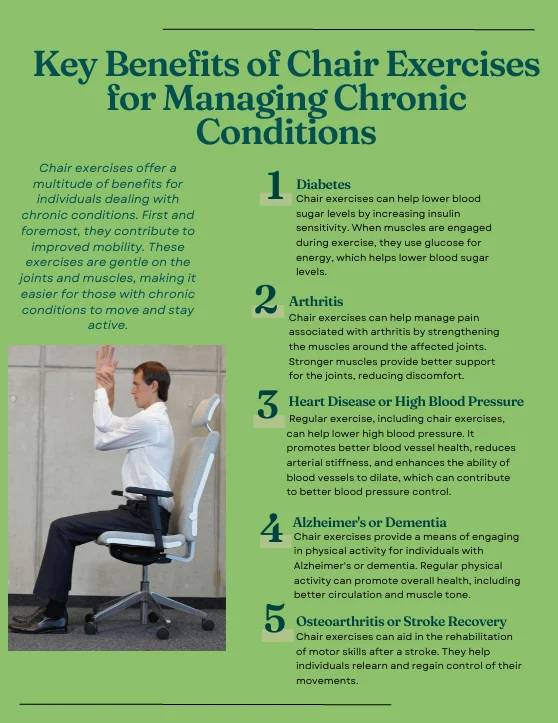
Alright, ladies (and the rest of you lovely readers), it's time to spill some tea—or rather, let’s uncork some wellness wisdom. You know those pesky chronic conditions that seem to gather like uninvited guests at a garden party?
Well, chair exercises are your polite, yet firm, “Please leave, we’re all set here” to conditions like diabetes, arthritis, and high blood pressure.
Now, I'm not saying chair exercises are the cure-all magic potion—although, wouldn't that be fabulous? But when it comes to managing chronic ailments, these easy-breezy routines can be as effective as that age-old family recipe for soothing the soul (and the joints, muscles, and heart).
Diabetes? Chair exercises help regulate blood sugar levels by giving your metabolism a loving nudge. Think of it as rebooting your system but without the annoying wait.
Arthritis? We've got you covered! These exercises are like that soothing lavender oil bath for your aching joints. Gentle yet effective, they keep stiffness at bay without requiring you to move like a gymnast.
Heart Disease or High Blood Pressure? Consider these exercises your heart's personal cheerleading squad, pushing you towards better cardiovascular health without the strain of a high-impact workout.
Alzheimer's or Dementia? Physical activity has been shown to improve cognitive function. Yep, these exercises aren't just muscle-deep; they can boost your brainpower too!
Osteoarthritis or Stroke Recovery? The modifiable nature of chair exercises allows you to set the pace, making them an excellent choice for maintaining or regaining strength and mobility.
Chair exercises are your golden ticket to not just living but thriving, even with chronic conditions.
With chair exercises, you're not just surviving; you're giving yourself the gift of better health and a zestier life. So, why not give it a whirl?
After all, the only thing you stand to lose is stiffness, stress, and perhaps a couple of unwanted pounds.
I can not say this enough: It is essential to consult with a healthcare provider before starting any new exercise program, especially if you have a chronic health condition.
Improving Strength and Flexibility
Brilliant, you’re in for a treat! Not only are we talking about boosting that upper body strength, but I’m also giving you a pocket-sized guide to some easy and effective exercises you can start doing right now.
Grab your trusty chair and let’s get those muscles moving!
Upper Body Strength
1. Seated Shoulder Press
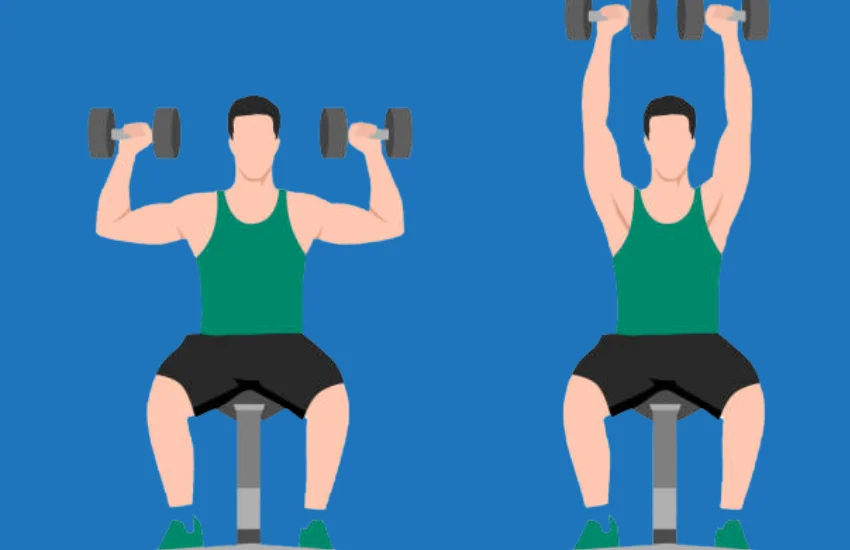
How-To: Sit up straight in your chair with your feet flat on the ground. Hold a water bottle in each hand (or small weights if you have them).
Start with your arms bent at a 90-degree angle, elbows at shoulder height. Push your hands toward the ceiling until your arms are fully extended, then bring them back down to the starting position.
Why It’s Fab: This exercise works wonders for your shoulders and arms, making everyday activities like lifting groceries or playing with the grandkids a breeze.
2. Seated Bicep Curls
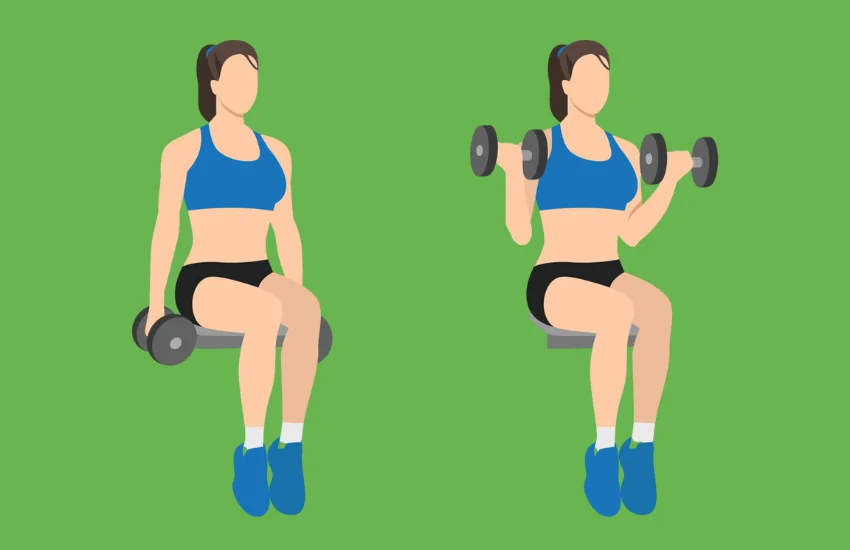
How-To: Sit tall, feet flat on the floor. Hold a water bottle in each hand, arms extended down by your sides.
Keep your upper arms stationary and bend your elbows, bringing the water bottles up toward your shoulders. Lower your arms back down to the starting position.
Why It’s Fab: Want toned arms that rival Michelle Obama’s? This is your go-to exercise. Plus, it’ll make carrying your favorite shopping bags feel like a walk in the park.
3. Chair Dips
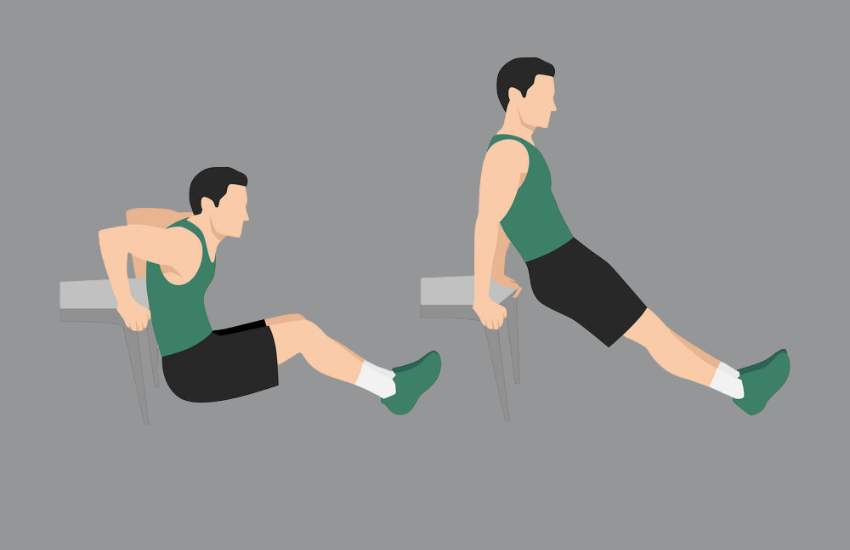
How-To: Sit at the edge of your chair, hands gripping the sides of the seat. Slide your bottom off the chair, lowering your body toward the floor while keeping your elbows at a 90-degree angle.
Use your arms to lift yourself back up to the starting position.
Why It’s Fab: This bad boy targets your triceps, making sure you’re flaunting strong and sculpted arms just in time for sleeveless season—or any season, because strong is always in style!
Feel free to do each exercise for 10-15 repetitions, and remember, consult your healthcare provider before beginning any new exercise program, especially if you have chronic conditions.
Lower Body Strength
So, we've talked about how chair exercises can turn you into an upper body powerhouse. But what about the lower half?
Well, hold onto your seats, ladies, because we're about to bring sexy back—or rather, bring back those toned legs and glutes you've been dreaming of.
Tone it Up Down There: Legs and Glutes
Think you need squats, lunges, and miles of running to get those legs in fabulous shape? Think again!
Your chair is your new best friend for achieving toned legs and a perky backside, all without breaking a sweat—or a heel!
1. Seated Leg Lifts
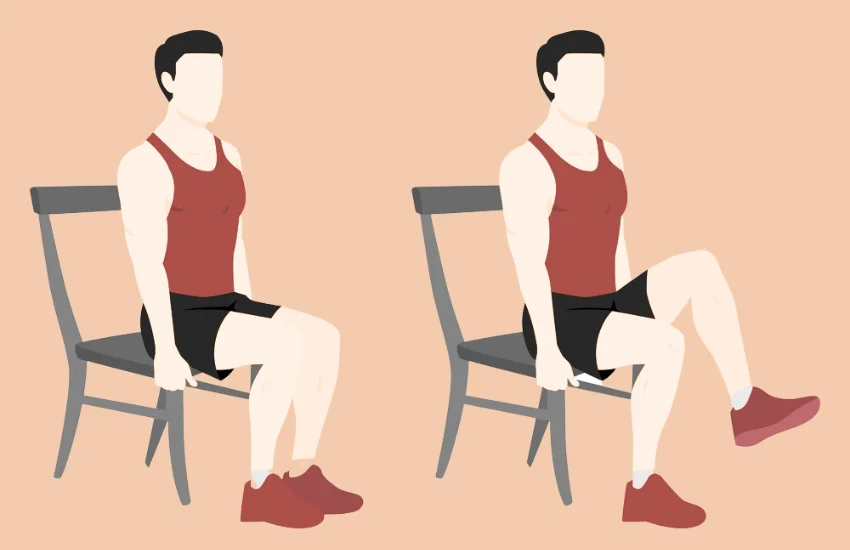
How-To: Sit up straight with your feet flat on the ground. Hold the edges of your seat for stability.
Slowly extend one leg straight out in front of you, keeping it elevated for a few seconds before lowering it back down. Repeat with the other leg.
Why It’s Fab: Hello, toned thighs and calves! This exercise helps you engage those muscles without putting too much strain on your joints.
Plus, it's a covert operation—you can totally do this while scrolling through your emails!
2. Seated Marches
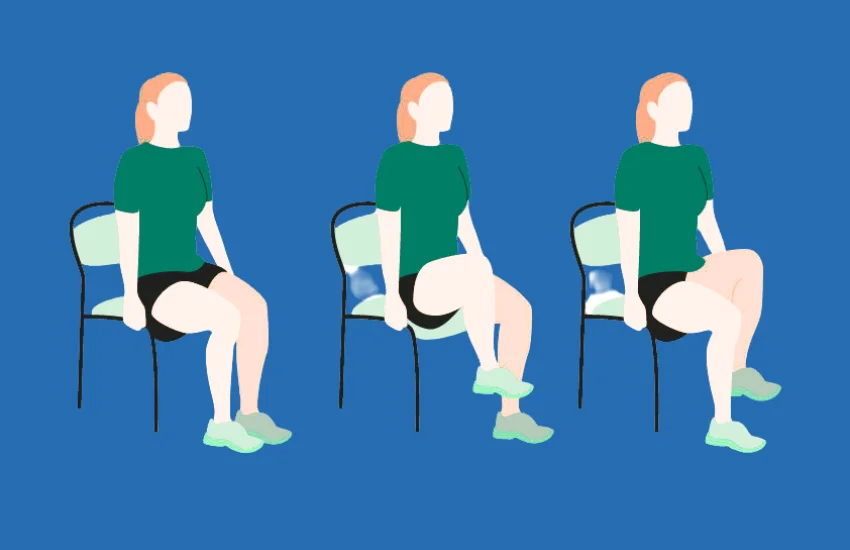
How-To: Sit tall with your feet flat on the floor. Holding the sides of your chair, lift one knee up toward your chest, and then lower it back down. Alternate legs as if you're marching.
Why It’s Fab: This exercise helps strengthen your hip flexors and thighs while engaging your core. It's like walking but seated—perfect for those days when a stroll around the block feels like a marathon.
3. Glute Squeezes
How-To: Sit tall in your chair, feet flat on the ground. Clench your glutes as tightly as you can, hold for a few seconds, and then release.
Why It’s Fab: This is the ultimate discreet exercise. You can tone your glutes while reading, watching TV, or even during a rather long Zoom meeting (we promise we won’t tell!).
Again, aim for 10-15 reps for each of these.
Core Stability
Well, ladies, we've given some love to the upper and lower body, but let's not forget the epicenter of it all—your core.
Whether you're looking to channel your inner belly dancer or simply want to pick up your grandkids without pulling something, a strong core is the secret ingredient to living life to its fullest.
Cinching it in the Middle: Abs and Back
Who needs endless crunches or complicated gym machinery when your trusty chair can be the gateway to a firmer, stronger core?
These chair exercises not only tone your abs but also give your back muscles the attention they deserve.
1. Seated Twists
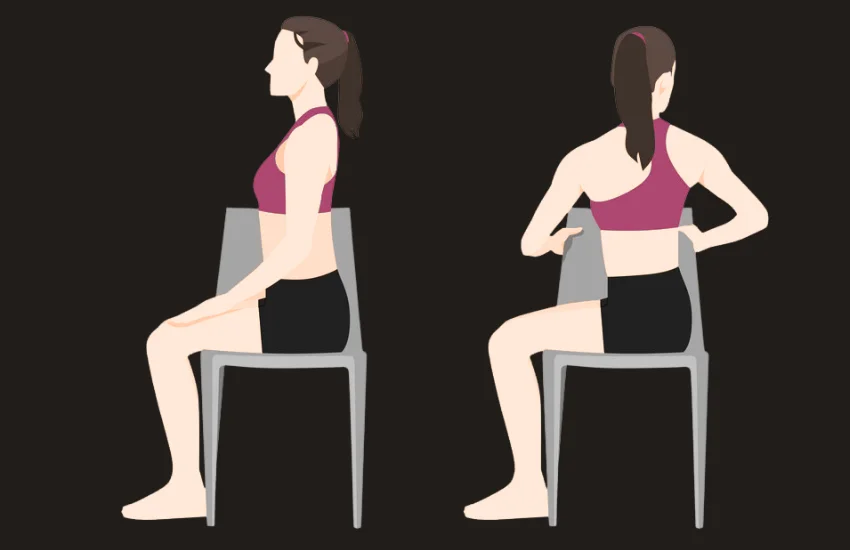
How-To: Sit upright with your feet flat on the ground. Hold a water bottle (or a small weight) with both hands at chest level.
Twist your upper body to the right, aiming to bring the water bottle toward your right hip. Return to the center and then twist to the left.
Why It’s Fab: This exercise not only tones your obliques (those side ab muscles) but also improves your spinal mobility. It's like salsa dancing but seated!
2. Seated Plank
How-To: Sit at the edge of your chair, feet flat on the ground. Place your hands on the armrests or the sides of the seat.
Engage your core and lift your hips off the chair, trying to bring your body into a straight line from shoulders to knees. Hold for a few seconds before lowering back down.
Why It’s Fab: This one's a core power-up, strengthening your abs, back, and shoulders all at once. Plus, it's a great warm-up for that gardening project you've been putting off.
3. Chair Sit-Ups
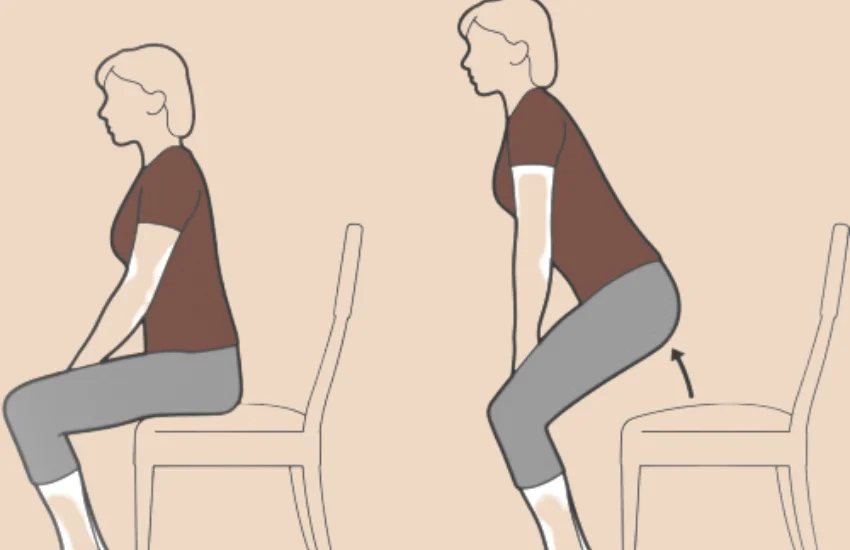
How-To: Sit at the edge of the chair, lean back until your back is just above the chair's seat, gripping the sides for support. Use your core muscles to pull yourself back to an upright position.
Why It’s Fab: Consider this the chair version of the classic sit-up. It works your abs without straining your neck or back, making it the perfect low-impact yet effective exercise for core strengthening.
Incorporating these exercises into your daily routine can help improve your overall health and well-being.
Enhancing Balance and Mobility
Alright, fabulous ladies, we've flexed our muscles, tightened our cores, and now it's time to talk about something that truly deserves a spotlight—balance and mobility.
Whether you're an on-the-go career woman, a world-traveling retiree, or a grandmother chasing after those adorable munchkins, stability on your feet is key to living your best life.
Graceful Living Starts with Stability
Just like a well-balanced diet and a well-balanced checkbook, a well-balanced body is essential to thriving, especially as we age or deal with chronic conditions. The beauty of chair exercises is that they’re not just about bulking up your muscles; they’re about creating a harmonious physique that keeps you steady and agile in your everyday life.
1. Seated Toe Taps
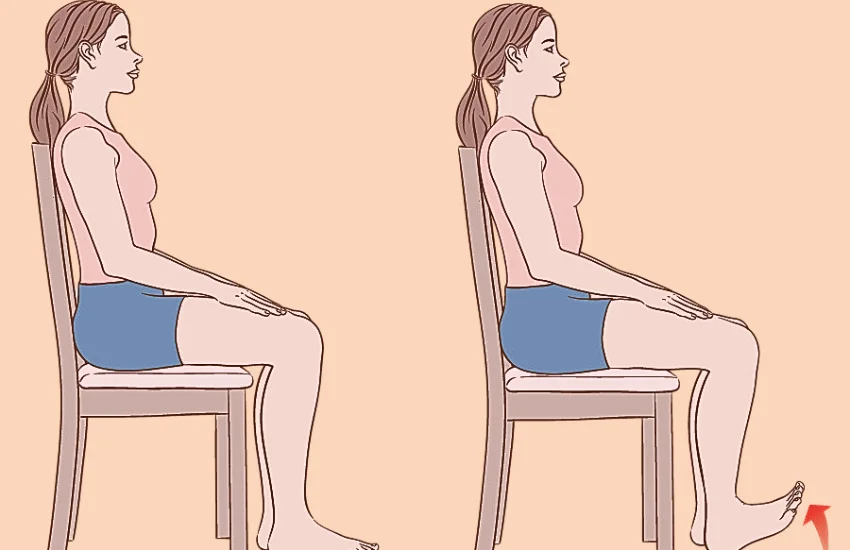
How-To: Sit tall in your chair, feet flat on the floor. Lift one foot off the ground and tap your toes, then place it back down. Alternate feet.
Why It’s Fab: This simple exercise works wonders for ankle flexibility, which is a big contributor to overall balance. Bonus points: it’s low-impact and easy on the joints.
2. Seated Side Leg Lifts
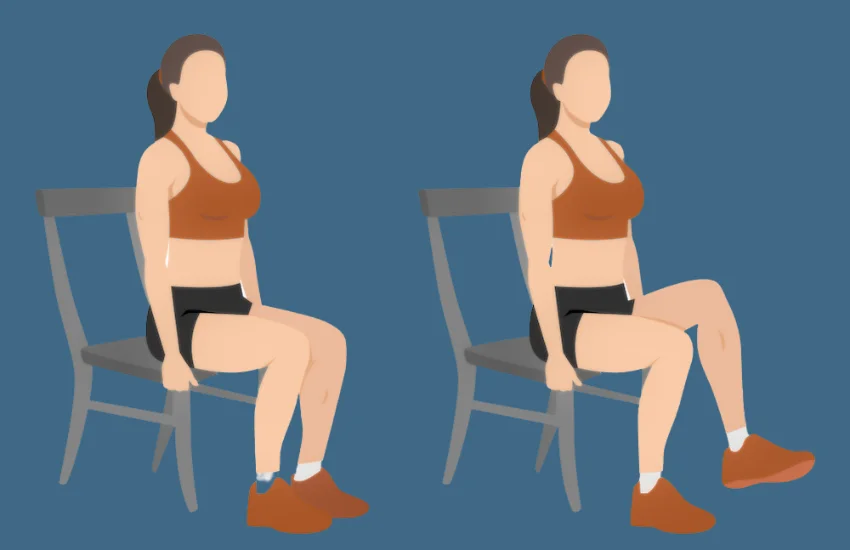
How-To: Sit up straight, gripping the sides of your chair. Extend one leg out to the side, keeping your foot flexed. Lift the leg as high as comfortable, then lower it back down. Repeat on the other side.
Why It’s Fab: This move strengthens your hips and thighs, which are the pillars of good balance. Plus, it gives you a nice, elongated leg line—who doesn’t want that?
3. Chair-Assisted Standing
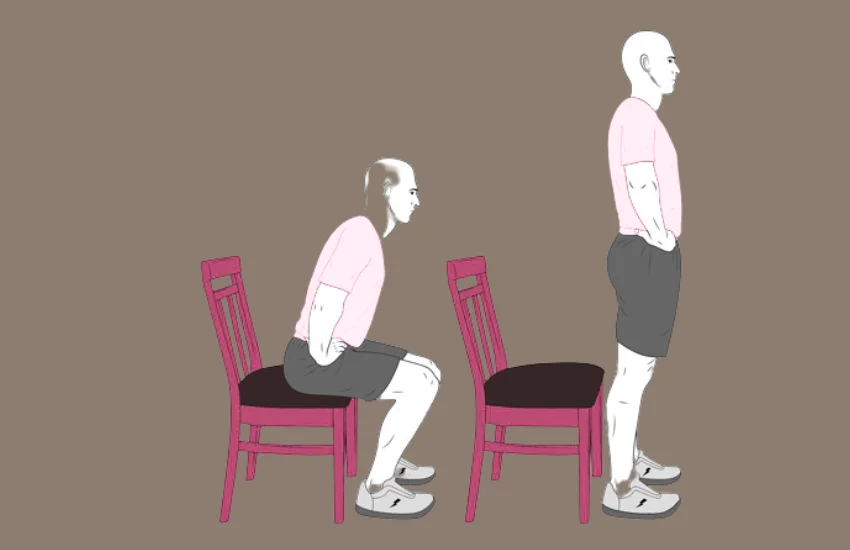
How-To: Sit at the edge of the chair, feet flat on the floor. Using your hands for support if needed, stand up and sit back down, trying to make the movement as smooth as possible.
Why It’s Fab: This exercise gets your quads and glutes involved and helps you practice the act of standing and sitting, which is basic but crucial for everyday mobility and reducing the risk of falls.
And, of course, a little housekeeping note: Consult your healthcare provider before diving into any new exercises, especially if you have existing health issues.
These chair exercises are as adaptable as your favorite little black dress. If you’re new to the exercise game, stick with the basics. As you gain more strength and confidence, feel free to mix in more advanced moves.
Reducing Pain and Discomfort
Oh, my achy-breaky back, right? Ladies, we've all been there, whether it's from desk jobs that have us sitting like pretzels or chronic conditions that make every move feel like a waltz with a porcupine. But here's the good news: chair exercises are your new BFFs when it comes to pain relief!
Ease that Squeeze: Arthritis and Joint Pain
We all love a good jar of pickles, but stiff, aching joints? Not so much. Chair exercises are a godsend for conditions like arthritis, as they allow you to work on your flexibility and range of motion without the jarring impact that can exacerbate pain.
1. Seated Wrist Rolls
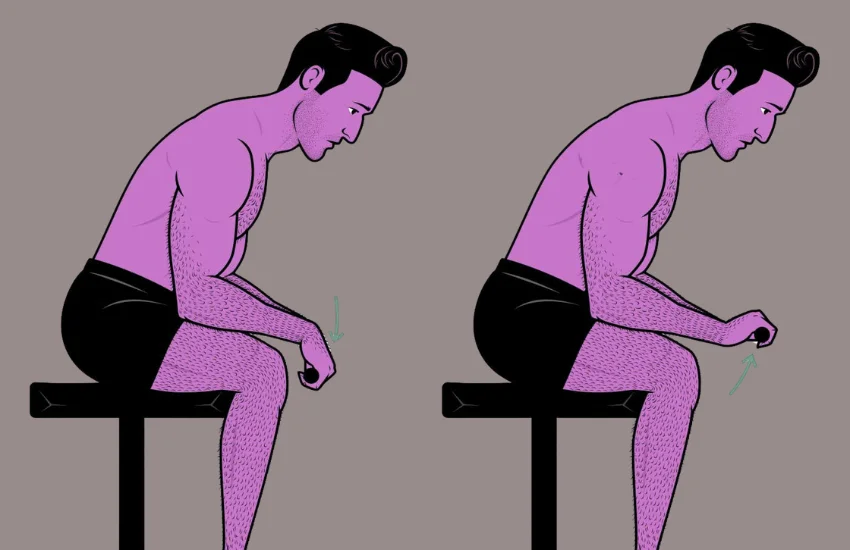
How-To: Sit up tall, rest your elbow on the arm of your chair, and let your wrist hang over the edge. Gently roll your wrist in a circular motion.
Why It’s Fab: This is a mini-workout for your wrist, which can be especially beneficial if you're experiencing arthritis pain in your hands. Plus, it's as easy as stirring your morning coffee.
Office-Friendly Moves-Desk Jockeys Rejoice
Let's face it, we can't all have ergonomic wonder-chairs or desks that transition to standing at the touch of a button. What you do have control over, however, is incorporating chair exercises that alleviate that awful back and neck tension.
2. Shoulder Rolls
How-To: Sit upright and slowly roll your shoulders forward in a circular motion, then reverse and roll them back.
Why It’s Fab: It loosens up the tension in your shoulders and upper back, which can be life-changing if you’re chained to a desk all day. It's the ‘ahhh' moment your body has been craving!
When Every Inch Hurts: Chronic Pain Conditions
For conditions like fibromyalgia where every inch of your body seems to protest, chair exercises can be your gentle approach to movement.
3. Seated Cat-Cow Stretch
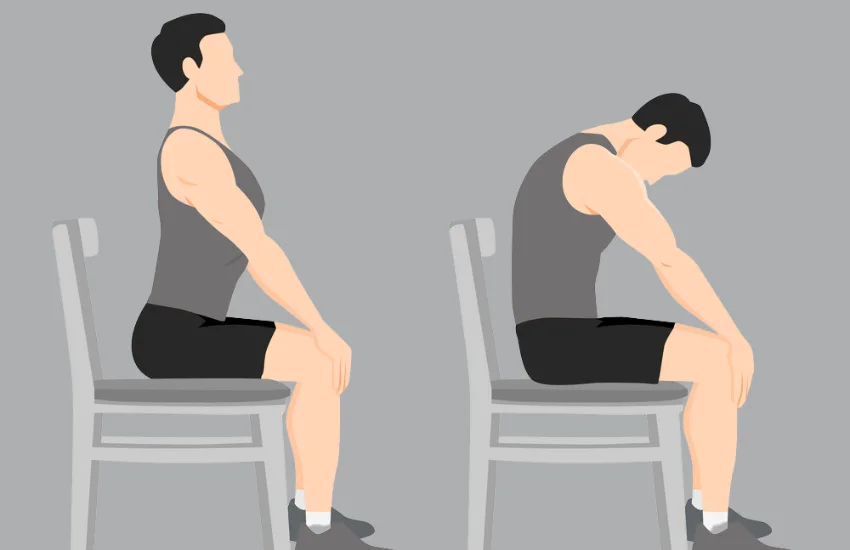
How-To: Sit tall with your hands on your knees. Arch your back, lifting your head and tailbone towards the ceiling for the Cow pose. Then, round your spine, tucking your chin to your chest for the Cat pose.
Why It’s Fab: This exercise improves spinal flexibility and can help release those feel-good endorphins. It's like a mini spa day for your back!
Boosting Mental Health
Mood swings, be gone! Exercise isn't just about sculpting those lovely curves or staying as nimble as a cat on a hot tin roof. It's also about shaping your mental state into something more fabulous.
Slay Stress, Feel Blessed
The American Psychological Association wasn’t just talking through its hat when it said regular exercise can be a game-changer for your mental well-being. It’s like a two-for-one deal; you get to trim that waistline while shedding some of those gnawing worries.
1. Breath Focus with Seated Twists
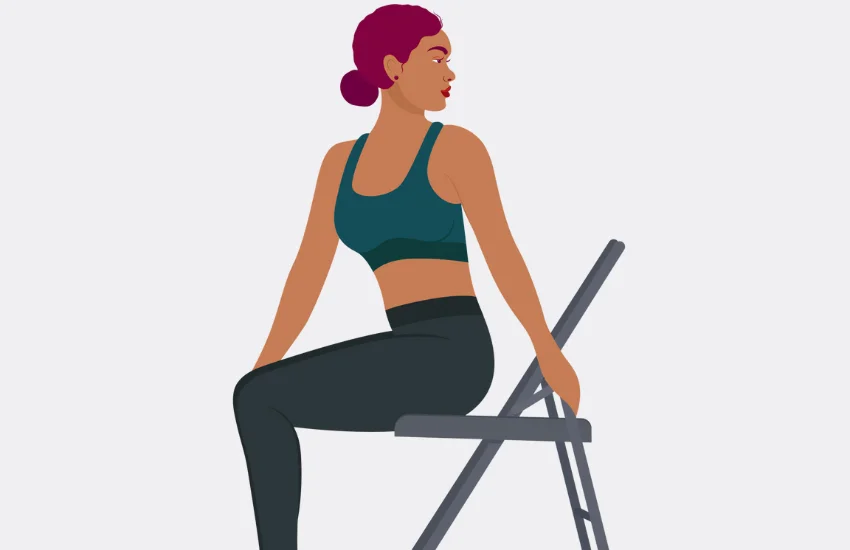
How-To: Sit up straight and inhale deeply. As you exhale, gently twist your torso to one side, using your hands to grip the armrest or side of your chair. Inhale to return to center.
Why It’s Fab: It's all about mindfulness here. This exercise helps you focus on your breath while also stretching your spine—boosting your mood and your flexibility in one go.
Embrace Your Inner Zen: The Endorphin Effect
Endorphins are like the fairy godmothers of your brain. With a wave of their magical wand—poof!—they can elevate your mood faster than you can say “pumpkin spice latte.”
2. Seated High Knees
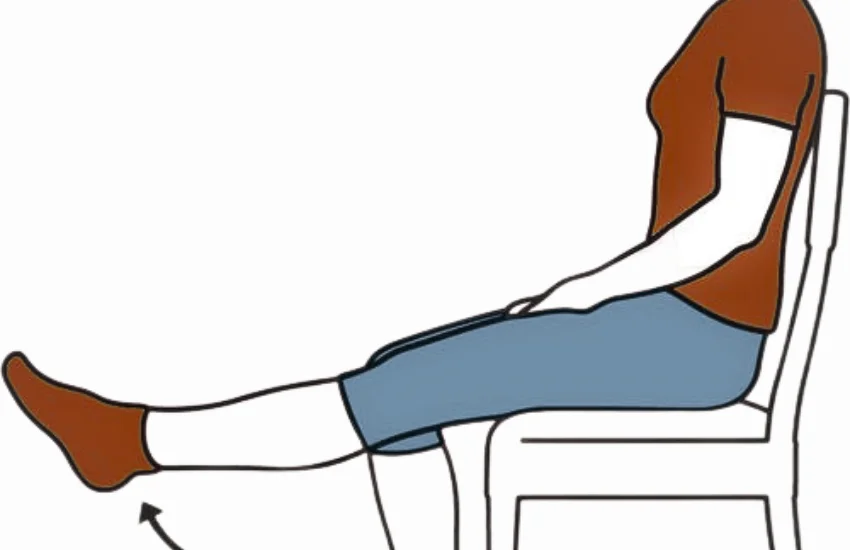
How-To: Sit at the edge of your chair and lift one knee toward your chest, then switch. Make this a quick, rhythmic movement.
Why It’s Fab: It gets your heart rate up, releases those darling endorphins, and before you know it, you’ll be humming a happier tune.
A Welcome Distraction: Mind Off, Chill On
Let's face it, sometimes our brains are like internet browser tabs: too many are open, and most are cluttered with nonsense. Exercise can be your brain’s “refresh” button.
3. Gentle Neck Tilts
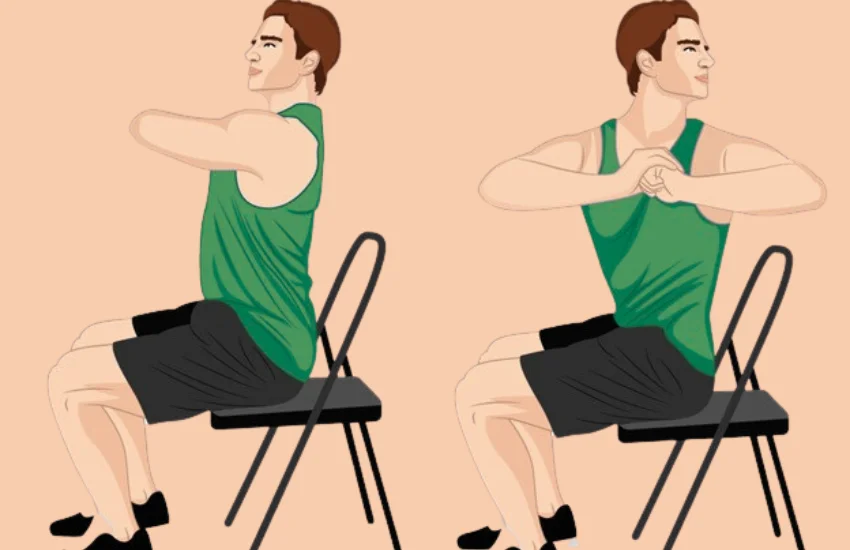
How-To: Sit tall, and simply tilt your head toward one shoulder. Hold for a few breaths and then tilt toward the other shoulder.
Why It’s Fab: It’s a quiet, meditative move that allows you a moment of peace—pushing aside worries and creating a little sanctuary in your mind.
For those dealing with chronic conditions, these low-impact chair exercises offer a way to take part in your own well-being without taxing your body.
Preventing Falls and Injuries
Listen up, you fearless lionesses! We all know that falls are no laughing matter, especially as we age or deal with chronic conditions.
Forget about charm school; what we need is balance school—and chair exercises are your first class.
The Three B's: Balance, Bones, and Bravery
The Journal of the American Geriatrics Society doesn't mince words:falls are the top cause of injury and, sadly, death among older adults.
So let's show those statistics who's boss by getting more balanced, sturdy, and yes, daring!
1. Seated Heel-Toe Taps
How-To: Sit at the edge of your chair, legs straight, and tap your heel, then toe, on the ground. Alternate feet.
Why It’s Fab: This easy-peasy lemon squeezy exercise helps improve your leg strength and awareness of how your feet connect to the ground—your first steps to becoming a balance guru.
Safety First, Darling
How splendid is it that you can improve your balance in the cozy, familiar setting of your own home? You can hold onto that sturdy chair or even touch a wall for extra support. And remember, the chair isn’t just for sitting; it’s your trusty sidekick on this balance-boosting journey.
2. Chair-Assisted Squats
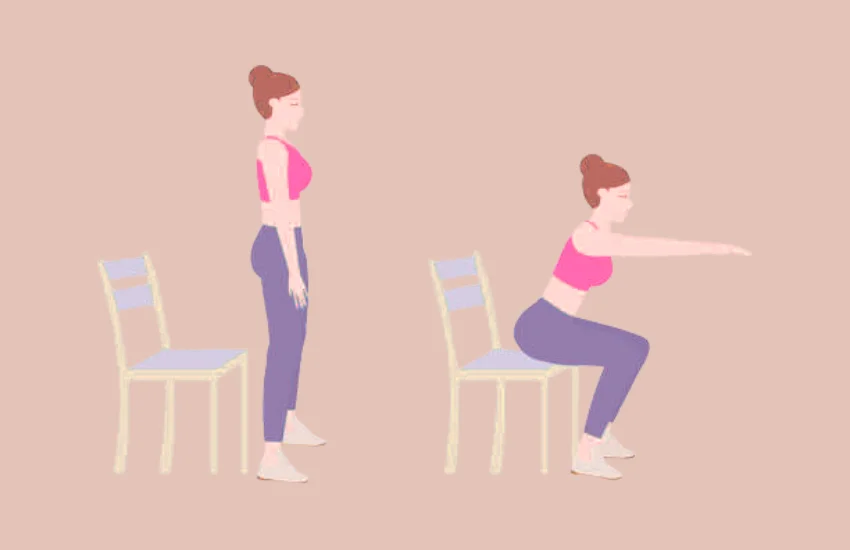
How-To: Stand in front of your chair, feet hip-width apart. Lower your booty as if you're about to sit but stop just before you touch the chair. Stand back up.
Why It’s Fab: You're not just working those legs; you're building trust in your ability to stand firm. Plus, strong legs mean a sturdy stance—and who couldn’t use a little extra sturdiness?
More Courage, Less Worry
Let's face it; the mere thought of falling can make us curl up on the couch. But guess what? A dash of bravery can go a long way. Consistent chair exercises can lessen that fear by boosting your confidence and helping you feel more secure on your two feet.
3. Seated March
How-To: Sit tall and march your feet in place, lifting your knees as high as you can.
Why It’s Fab: Besides giving you a lovely posture (your mother would be so proud!), this exercise gradually strengthens those muscles that keep you upright and in control.
Chair exercises are not just about staying active; they're about giving you the confidence and strength to face the world—gracefully, of course.
As always, consult your healthcare provider before starting a new routine. Are you ready to embrace your inner balancing act?
Chair Exercises for Different Age Groups
Regular exercise is important for people of all ages, but it can be difficult for older adults and those with limited mobility to engage in physical activity.
Chair exercises are a great way for people of all ages and abilities to stay active and improve their overall health. Here are some chair exercises for seniors and adults with limited mobility.
Exercises for Seniors
Alright, you silver foxes and golden girls, this one’s for you! Age might be just a number, but let's make that number shine brighter with some low-impact, chair-assisted flair.
The Golden Trio: Balance, Flexibility, and Strength
We may not be in our 20s anymore, but who says we can't still be fabulous? Chair exercises offer us a way to age like fine wine—keeping our balance, flexibility, and strength on point.
Best of all? They’re easy on the joints, so you can say “sayonara” to pain while you’re at it!
1. Gentle Seated Leg Lifts
How-To: Sit up tall with your feet flat on the ground. Lift one leg up, keeping your knee straight. Lower it back down and switch legs.
Why It’s Fab: Are your legs craving a stretch? This exercise works wonders on those leg muscles while being super gentle on the joints.
2. Seated Side Taps
How-To: Sit at the edge of your chair, both feet planted. Tap your right foot to the side, then bring it back. Alternate with the left foot.
Why It’s Fab: Aside from making you feel like a tap dancer in your prime, this move improves your side-to-side stability. Talk about moving and grooving with grace!
3. Seated Windmills
How-To: Sit up straight, extend your arms out to your sides, and rotate your torso to the right and then to the left.
Why It’s Fab: Who knew you could do the twist while seated? This exercise is a sassy way to work your core and add some flexibility to your daily routine.
Whether you’re a senior or just aspiring to be one of those glamorous grandmas you see in movies, chair exercises can put a bounce back into your step—or your sit!
And remember, a healthcare provider should be your first stop before changing up your exercise routine. Ready to make those golden years truly sparkle?
Chair Exercises for Adults with Limited Mobility
Hold the phone, lovelies! You don’t have to be a marathon runner to glow with health and vitality. If you’re someone who finds traditional gym workouts to be a hassle or if you're living with limited mobility, chair exercises are your new best friends.
Why Chair Exercises Are Your Mobility BFFs
Now, we're not just talking about avoiding the dreaded muscle atrophy here. We're aiming for a life that's rich in movement, flexibility, and maybe even a few dance moves at the next family wedding.
Here’s the tea: chair exercises are a wonderful way to circulate those good vibes, and yes, blood too, all around your body.
1. Seated Ankle Rolls
How-To: While seated, extend one leg forward and simply roll your ankle clockwise and then counter-clockwise.
Why It’s A Win: This little gem of a move helps to keep your ankles flexible and can even perk up blood circulation in your feet. A must-try if you love those summer sandals as much as I do!
2. Chair Salsa
How-To: With your feet flat, sway your hips to the left and then to the right. Feel the rhythm of the beat!
Why It’s A Win: Call it Chair Zumba or a seated salsa, but this will not only work your waistline but will also bring a smile to your face. Arriba!
3. Armchair Marches
How-To: Sit with your feet flat and your back supported. March one foot and then the other, lifting your knees as high as is comfortable.
Why It’s A Win: Want to feel like you’re marching in a parade, but without the actual parade? This exercise is good for keeping those hip flexors and knees in tip-top shape.
By incorporating these chair exercises into their daily routine, seniors and adults with limited mobility can improve their overall health and well-being.
It is important to consult with a healthcare professional before starting any new exercise program, especially if you have a chronic condition or injury.
Creating Your Own Chair Exercise Program: Roll Out the Yoga Mat, Darling
So, you're on board with this chair exercise jazz—awesome! But before you dive in, let's lay down some groundwork to ensure you're not just fumbling around in your favorite recliner.
Think of it as setting the table before a fabulous dinner party. Here's how to make your chair exercise program the toast of your own personal wellness journey.
The Importance of a Warm-Up
Ladies, would you ever hit the town without a little mascara and lip gloss? I thought not! Similarly, you should never dive into any exercise regimen without a warm-up.
Think of it as the primer to your full-body makeup routine—a crucial first step that prepares you for the show-stopping main event.
A Few Star-Studded Warm-Up Acts to Consider
- Seated Side Stretches
- How-To: While sitting, extend your arms over your head and lean gently to the left and then to the right.
- Why It's Fabulous: This loosens up your sides and gets your upper body ready for those disco dance moves, or, you know, arm circles.
- Ankle and Wrist Rolls
- How-To: Rotate your ankles and wrists in little circles.
- Why It's Fabulous: The divas of your limbs—the wrists and ankles—need a proper introduction to the stage before the big performance. This helps with joint flexibility.
- Neck Tilts
- How-To: Gently tilt your head to each side, easing into the stretch without forcing it.
- Why It's Fabulous: You're releasing tension and preparing your neck for a variety of movements, or simply to gaze adoringly at your cute grandkids (or pets, or both!).
Remember, warming up is like sending out the invites before your dinner party—it sets the tone and makes everything that follows flow beautifully.
Consult your healthcare professional before starting any new exercise program, especially if you're managing a chronic condition. Alright ladies, shall we dance?
Choosing the Right Exercises
When choosing exercises for a chair program, it is important to consider your individual needs and abilities. Some exercises may not be appropriate for certain chronic conditions or injuries.
It is best to consult with a healthcare professional or certified exercise specialist to determine which exercises are safe and effective for you. Some good exercises to consider for a chair program include:
- Seated leg lifts
- Chair squats
- Seated rowing
- Bicep curls
Setting Goals
Setting goals can help to keep you motivated and on track with your exercise program. When setting goals, it is important to make them specific, measurable, and achievable. For example, a goal could be to perform 10 chair squats without stopping within a month. Another goal could be to increase the number of repetitions or sets for a particular exercise.
Tracking Progress
Tracking progress can help you to see how far you have come and provide motivation to keep going. Some ways to track progress include:
- Keeping a journal of exercises performed and repetitions completed
- Using a pedometer or fitness tracker to track steps taken
- Taking measurements of body weight, body fat, and muscle mass
By implementing a chair exercise program with a warm up, choosing the right exercises, setting goals, and tracking progress, individuals with chronic conditions can unlock the many benefits of exercise.
Safety Measures and Precautions
When engaging in chair exercises, it is important to take certain safety measures and precautions to avoid injury and ensure a safe and effective workout. Here are some key tips to keep in mind:
1. Consult with Your Doctor
Before starting any new exercise program, it is important to consult with your doctor, especially if you have a chronic condition or are recovering from an injury. They can provide guidance on what types of exercises are safe and appropriate for you, as well as any modifications you may need to make.
2. Start Slowly and Gradually Increase Intensity
When starting a new exercise program, it is important to start slowly and gradually increase the intensity over time. This helps prevent injury and allows your body to adapt to the new demands being placed on it. If you experience pain or discomfort during exercise, stop immediately and consult with your doctor.
3. Use Proper Form
Using proper form is essential to prevent injury and ensure a safe and effective workout. Make sure to follow the instructions provided by your instructor or trainer, and pay attention to your body alignment and posture.
4. Stay Hydrated
Staying hydrated is important during any exercise program, especially if you have a chronic condition. Make sure to drink plenty of water before, during, and after your workout to prevent dehydration.
5. Listen to Your Body
Listening to your body is key to preventing injury and avoiding overexertion. If you experience pain, dizziness, or shortness of breath during exercise, stop immediately and rest. If symptoms persist, consult with your doctor.
By following these safety measures and precautions, you can unlock the benefits of chair exercises for chronic conditions while minimizing your risk of injury.
Consulting with Health Professionals
We've journeyed through the wondrous world of chair exercises, but there's one final encore before we call it a wrap: consulting your healthcare professionals.
Think of this step as the finishing touch, the final sprinkle of glitter before your star-studded performance.
Your Personal Glam Squad: Doctors and Physical Therapists
Your doctor isn't just there to scold you about eating too much chocolate; they're also your first point of contact when you're getting ready to start any new exercise program. Your physician is the VIP guest at your wellness soirée.
Physical Therapists are the costume designers of your health journey—they make sure everything fits just right. They'll tailor your exercise program, ensuring your movements are as dazzling as they are safe.
How They Add That Showbiz Sparkle
- Safety Checks: Your healthcare professional will give you the green light on which chair exercises suit you best, especially if you're managing a chronic condition.
- Form and Technique: Like a seasoned choreographer, your PT can guide you through each step, making sure you're hitting those marks without risking injury.
- Personalized Tips: Have specific concerns? Unique conditions? Your healthcare team can adapt your program, turning it into a bespoke experience tailored just for you.
Special Considerations for Chronic Conditions
If you've got chronic conditions like arthritis, your healthcare professionals are like the director who knows exactly how to showcase your talents without putting too much pressure on you. They'll recommend any necessary modifications to your routine.
Don't Skip the Final Act
Think of this as the standing ovation at the end of your show. It's the moment where you acknowledge the pros who got you there, and the wisdom they've imparted.
So before you embark on this incredible chair exercise journey, make that appointment. You'll be so glad you did, darling.
The Grand Finale: Seize Your Throne and Rule Your Wellness Kingdom
Step aside, traditional gym workouts—there's a new monarch in the realm of health and wellness, and it comes with armrests and cushioning.
That's right, chair exercises are not just the court jesters of the fitness world; they're taking the crown for being a versatile and inclusive approach to well-being.
Especially for those navigating the challenging landscapes of chronic conditions, chair exercises serve as a steadfast chariot, empowering you to reclaim your health without leaving your throne.
From turning the tides on chronic conditions like diabetes and heart disease to reinforcing the fortress of your body against falls and injuries, the gains are nothing short of royal.
The scepter of better posture? Yours. The jewel-encrusted crown of cardiovascular health? Claim it. All from the comfort of your own castle—be it a humble abode or a high-rise kingdom.
But don't embark on this noble quest unaided. Assemble your council of healthcare wizards—doctors and physical therapists—to guide you on this journey.
They'll help you tailor your fitness strategy to your unique constitution and keep you from straying into the dragons' den of potential risks.
However, remember: ruling a kingdom is a holistic endeavor. A steady throne requires more than physical might; it needs the balance of a well-rounded lifestyle. Nutrition is your harvest, sleep your rejuvenation potion, and stress management your diplomatic strategy.
Each complements your chair exercise regimen, enabling you to reign supreme over your wellness dominion.
So go forth, valiant souls! Equip yourselves with the empowering armor of chair exercises and conquer the realm of health and quality of life. This isn't just a conclusion; it's your call to arms. Let the coronation begin!
FAQs
A: Chair exercises offer a range of benefits for individuals with chronic conditions. They can improve cardiovascular health, increase muscle strength and flexibility, and reduce the risk of falls. Regular exercise can also help manage chronic pain, reduce stress and anxiety, and improve overall quality of life.
A: Chair exercises are a great option for individuals with limited mobility as they provide a safe and effective way to exercise. They can help improve range of motion, increase flexibility, and build strength in the muscles that support mobility. Additionally, chair exercises can help improve balance and coordination, which can reduce the risk of falls.
A: There are many fun and effective chair exercises that seniors can do to improve their fitness. Some examples include seated leg lifts, arm circles, seated marching, and chair yoga. These exercises can help improve strength, flexibility, and balance, while also providing a fun and engaging way to stay active.
A: While chair exercises may not burn as many calories as more vigorous forms of exercise, they can still be an effective way to support weight loss. By building muscle and increasing metabolism, chair exercises can help individuals burn more calories throughout the day. Additionally, regular exercise can help reduce appetite and improve overall dietary habits.
A: Chair exercises can be a great option for individuals with disabilities in their legs, as they provide a way to exercise without putting pressure on the lower body. Seated exercises can help improve strength and flexibility in the upper body, while also providing cardiovascular benefits. Additionally, chair exercises can help improve overall mood and reduce stress.
A: Seated exercises are a good option for elderly individuals as they provide a safe and effective way to exercise. They can help improve strength, flexibility, and balance, while also reducing the risk of falls. Additionally, seated exercises can be modified to meet individual needs and abilities, making them a great option for individuals of all fitness levels.

